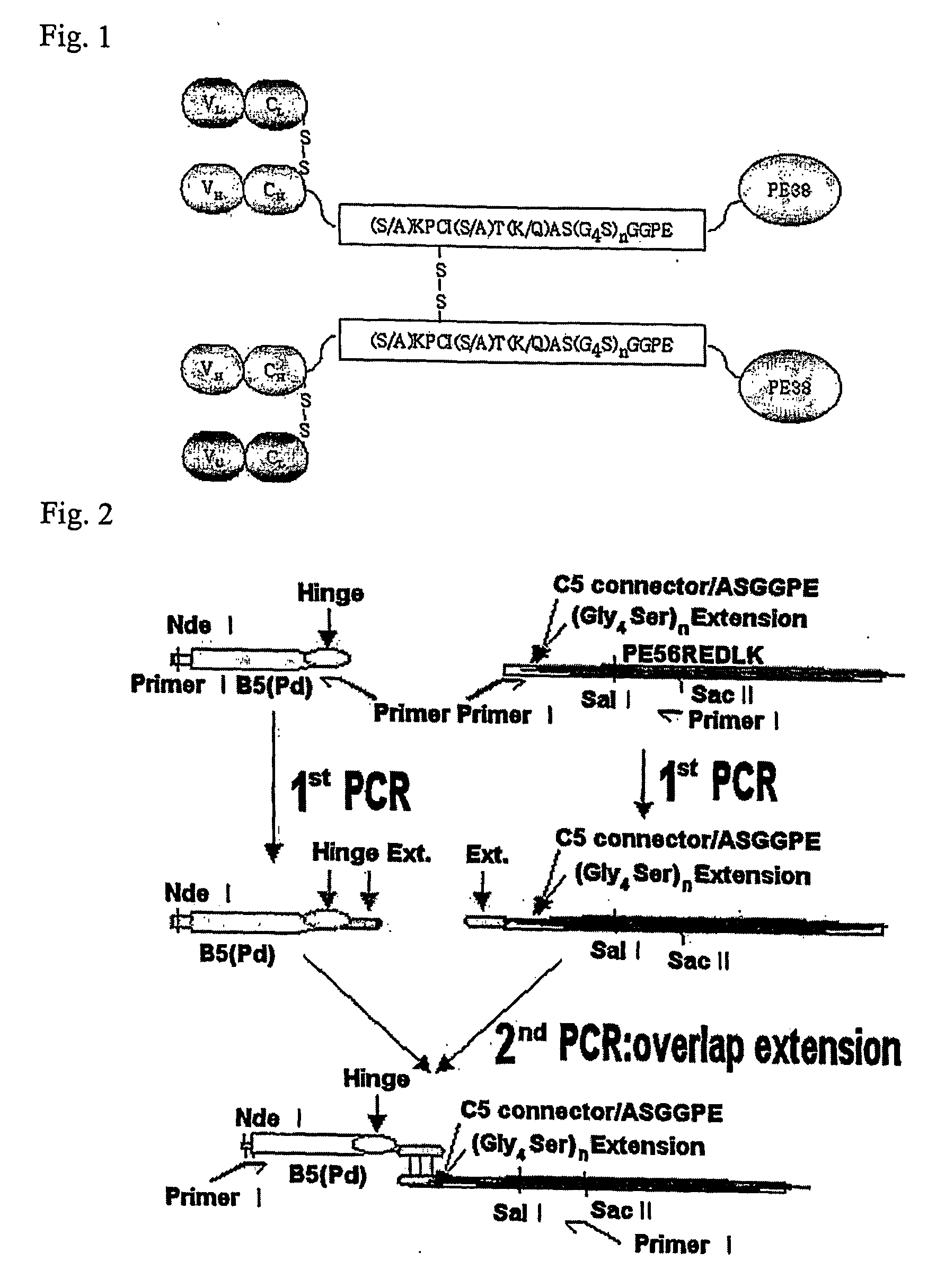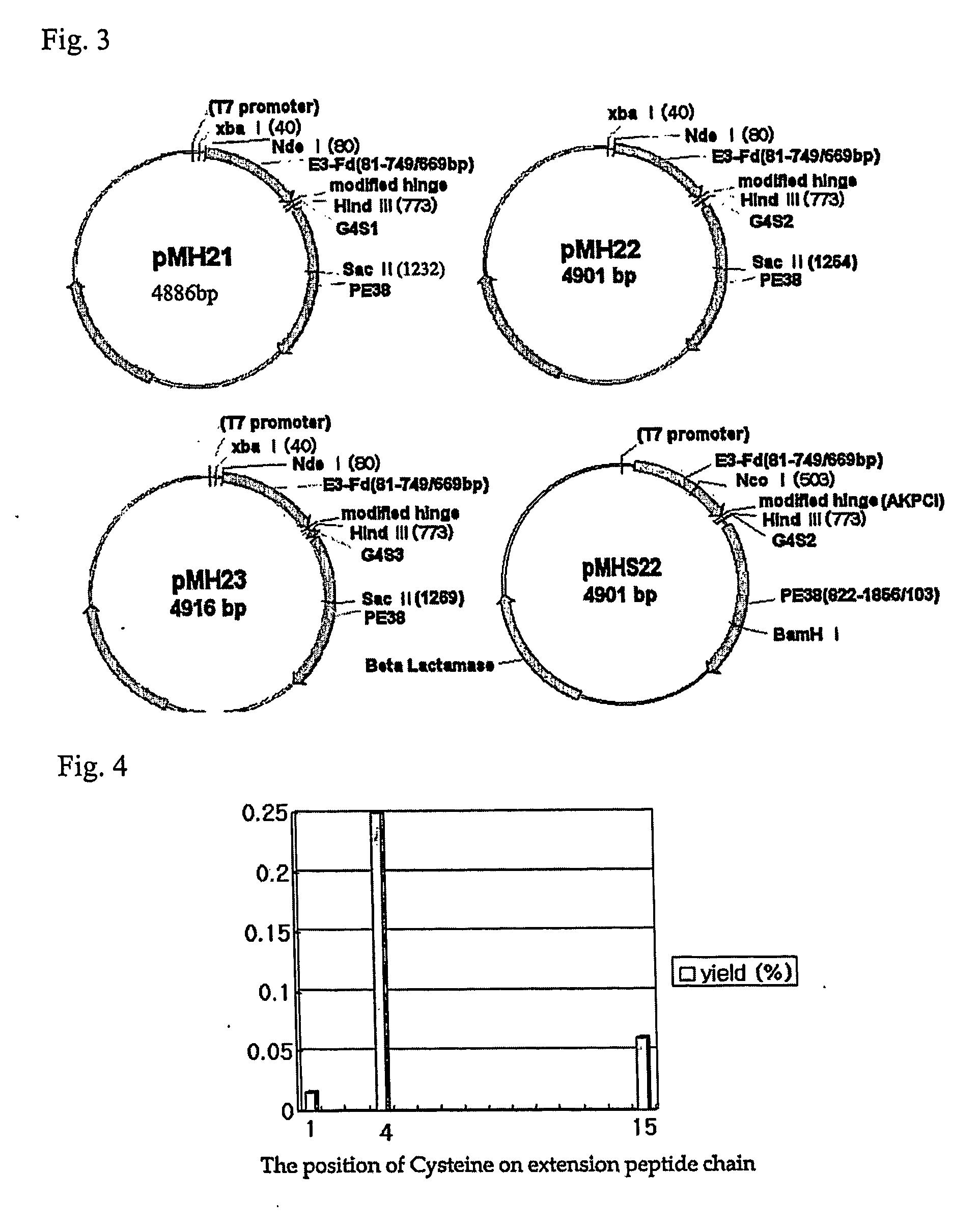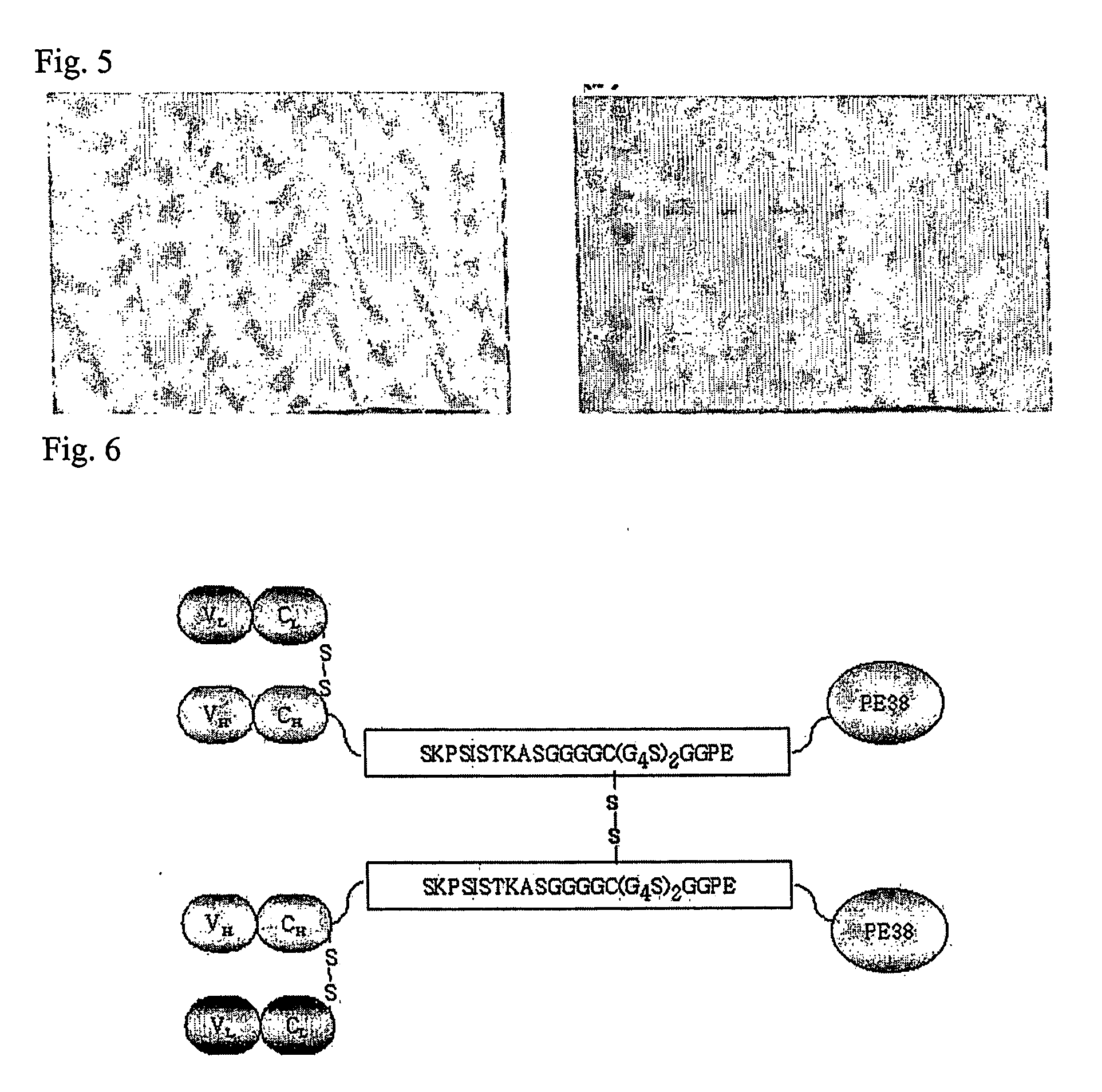Dimer of chimeric recombinant binding domain-functional group fusion formed via disulfide-bond-bridge and the processes for producing the same
a technology of chimeric recombinant and functional group, which is applied in the direction of immunoglobulins against animals/humans, peptides, enzymology, etc., can solve the problems of short half-life rate of antibody-toxin functional group, and low production yield. , to achieve the effect of double binding valency, excellent functional efficiency and high structural stability
- Summary
- Abstract
- Description
- Claims
- Application Information
AI Technical Summary
Benefits of technology
Problems solved by technology
Method used
Image
Examples
example 1
Production of Dimers which have Ext(4CLFA5X=4CL15FA11, 4CL20FA16, 4CL25FA21, AQ4CL20FA16) with Fixed Uncoupled Cysteine at Fourth Amino Acid Position and Additional Increase of Five Flexible Amino Acids in its Flexible Linker Sequence(LFA)
[0131] [B3(Fab)-Ext(4CLFA5X=4CL15FA11, 4CL20FA16, 4CL25FA21, AQ4CL20FA16)-toxin]2 has uncoupled Cysteine at fixed 4th position and has an extension peptide chain for the formation of the dimer with five amino acid additional increase in flexible amino acids linker(LFA).
[0132] On this example, the uncoupled Cysteine in the fourth location from the Fab of B3 antibody is fixed to induce dimer formation and with the uncoupled Cysteine, different numbers of flexible amino acids on extension peptide chain were put in between Fd and toxin domain to compare production yield fluctuation caused by three-dimensional steric space difference. 11, 16, 21 flexible amino acids which make the length of Linker to be 15, 20, 25 were used on this test. Alanine was u...
example 2
The Dimerization and Effects of Antibody-Toxin Fusion that has Extension Peptide Chain(Ext) with Uncoupled Cysteine at the 15th Position and 14 Amino Acids Linker(LFA) Containing 13 Flexible Amino Acids
[0164] In this example, the B3(Fd)-Ext(15CL14FA13)-PE38 was newly constructed. The flexible peptide G4C(G4S)2 was inserted following the fourth Serine on extension chain SKPSISTKASGGPE of B3(Fd)-PE38. The Cysteine on sequence derived from antibody hinge sequence was all changed into Serine that does not form disulfide bond. The composition of B3(Fd)-Ext(15CL14FA13)-PE38 is same to B3(VH)-B3(CH1)-SKPSISTKASGGGGCGGGGSGGGGSG GPE-PE38. The uncoupled Cys on Ext forms disulfide binds between two B3(Fab)-Ext(15CL14FA13)-PE38 monomers. The uncoupled Cys was located at 15th position of extension chain compared to the previous example which uses uncoupled Cys on 1st position which is [B3(FabH1)-PE38]2(=[B3(Fab)-Ext(1CL13FA7)-PE38]2)(protein from pCE1) to place Cys far from binding domain Fab a...
example 3
The Dimerization of Antibody-Toxin Fusion that has Extension Peptide Chain(Ext) with Uncoupled Cysteine at the 1st Position and 13 Amino Acids Linker(LFA) Containing 7 Flexible Amino Acids
[0175] The B3(Fab) and PE38 are used in constructing divalent immunotoxin [B3(FabH1)-PE38]2 (=[B3(Fab)-CKPSISTKASGGPE-PE38]2)(=[B3(Fab)-Ext(1CL13FA7)-PE38]2). The divalent immunotoxin B3 has about 174.4 kDa of molecular weight and comprises two light chain of B3 and two chains composed of B3(Fd) fused with PE38. There are three Cysteines on the hinge sequence of B3 antibody. The rear two Cysteines are changed to Serines and only the front Cysteine is used to make the Ext chain. It forms disulfide bond between monovalent immunotoxin to produce dimer.
(Materials and Methods)
[0176] The method used are same as example 1. MTT(3-[4,5-Dimethylthiazol-2-yl]-2,5-diphenyltetrazolium bromide) from Sigma Co. was used at 1.5 mg / mL final concentration. Cy5TM AutoReadTM sequencing kit for sequence analysis was...
PUM
| Property | Measurement | Unit |
|---|---|---|
| concentration | aaaaa | aaaaa |
| volume | aaaaa | aaaaa |
| volume | aaaaa | aaaaa |
Abstract
Description
Claims
Application Information
 Login to View More
Login to View More - R&D
- Intellectual Property
- Life Sciences
- Materials
- Tech Scout
- Unparalleled Data Quality
- Higher Quality Content
- 60% Fewer Hallucinations
Browse by: Latest US Patents, China's latest patents, Technical Efficacy Thesaurus, Application Domain, Technology Topic, Popular Technical Reports.
© 2025 PatSnap. All rights reserved.Legal|Privacy policy|Modern Slavery Act Transparency Statement|Sitemap|About US| Contact US: help@patsnap.com



